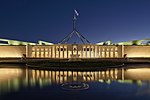Australian House of Representatives

The House of Representatives is the lower house of the bicameral Parliament of Australia, the upper house being the Senate. Its composition and powers are established in Chapter I of the Constitution of Australia. The term of members of the House of Representatives is a maximum of three years from the date of the first sitting of the House, but on only one occasion since Federation has the maximum term been reached. The House is almost always dissolved earlier, usually alone but sometimes in a double dissolution of both Houses. Elections for members of the House of Representatives are often held in conjunction with those for the Senate. A member of the House may be referred to as a "Member of Parliament" ("MP" or "Member"), while a member of the Senate is usually referred to as a "Senator". The government of the day and by extension the Prime Minister must achieve and maintain the confidence of this House in order to gain and remain in power. The House of Representatives currently consists of 151 members, elected by and representing single member districts known as electoral divisions (commonly referred to as "electorates" or "seats"). The number of members is not fixed but can vary with boundary changes resulting from electoral redistributions, which are required on a regular basis. The most recent overall increase in the size of the House, which came into effect at the 1984 election, increased the number of members from 125 to 148. It reduced to 147 at the 1993 election, returned to 148 at the 1996 election, increased to 150 at the 2001 election, and stands at 151 as of the 2022 Australian federal election.The House of Representatives chamber is designed to seat up to 172 Members, with provision for an ultimate total of 240 to be accommodated.Each division elects one member using full-preferential instant-runoff voting. This was put in place after the 1918 Swan by-election, which Labor unexpectedly won with the largest primary vote and the help of vote splitting in the conservative parties. The Nationalist government of the time changed the lower house voting system from first-past-the-post to full-preferential voting, effective from the 1919 general election.
Excerpt from the Wikipedia article Australian House of Representatives (License: CC BY-SA 3.0, Authors, Images).Australian House of Representatives
Parliament Drive,
Geographical coordinates (GPS) Address Nearby Places Show on map
Geographical coordinates (GPS)
| Latitude | Longitude |
|---|---|
| N -35.308611111111 ° | E 149.125 ° |
Address
Parliament Drive
2600 , Capital Hill
Australia
Open on Google Maps







